I am seeking feedback, including comment and corrections, on this draft blog post. I have previously sent an email to Richard Vevers (1 October 2021) and placed a request for more information at the Catlin Survey website (20 April 2021), without receiving any response from either. Irus Braverman was kind enough to reply to my email (30 September 2021) indicating that the photograph used in her book Coral Whisperers was provided to her by Richard Vevers.
If all science is either ‘physics’ or ‘stamp collecting’ as once suggested by Ernest Rutherford, I would argue that it is important that we not knowingly distribute fakes.
Corals Healthy, Photograph Bleached – Draft
Does it matter if the Internet is replete with fake photographs accompanying fake stories? Does it matter that these photographs keep children awake at night – worrying about climate change and the impending doom of our Great Barrier Reef?
There is a photograph that has been promoted by Richard Vevers, the founder, and CEO of The Ocean Agency, a Washington-based international not-for-profit that is purportedly dedicated to marine conservation. It is described on his The Ocean Agency website as having been taken at Heron Island in 2015. On Flickr, the same photograph is described as having been taken in 2014, and in Irus Braverman’s book Coral Whisperers as having been taken in 2016.
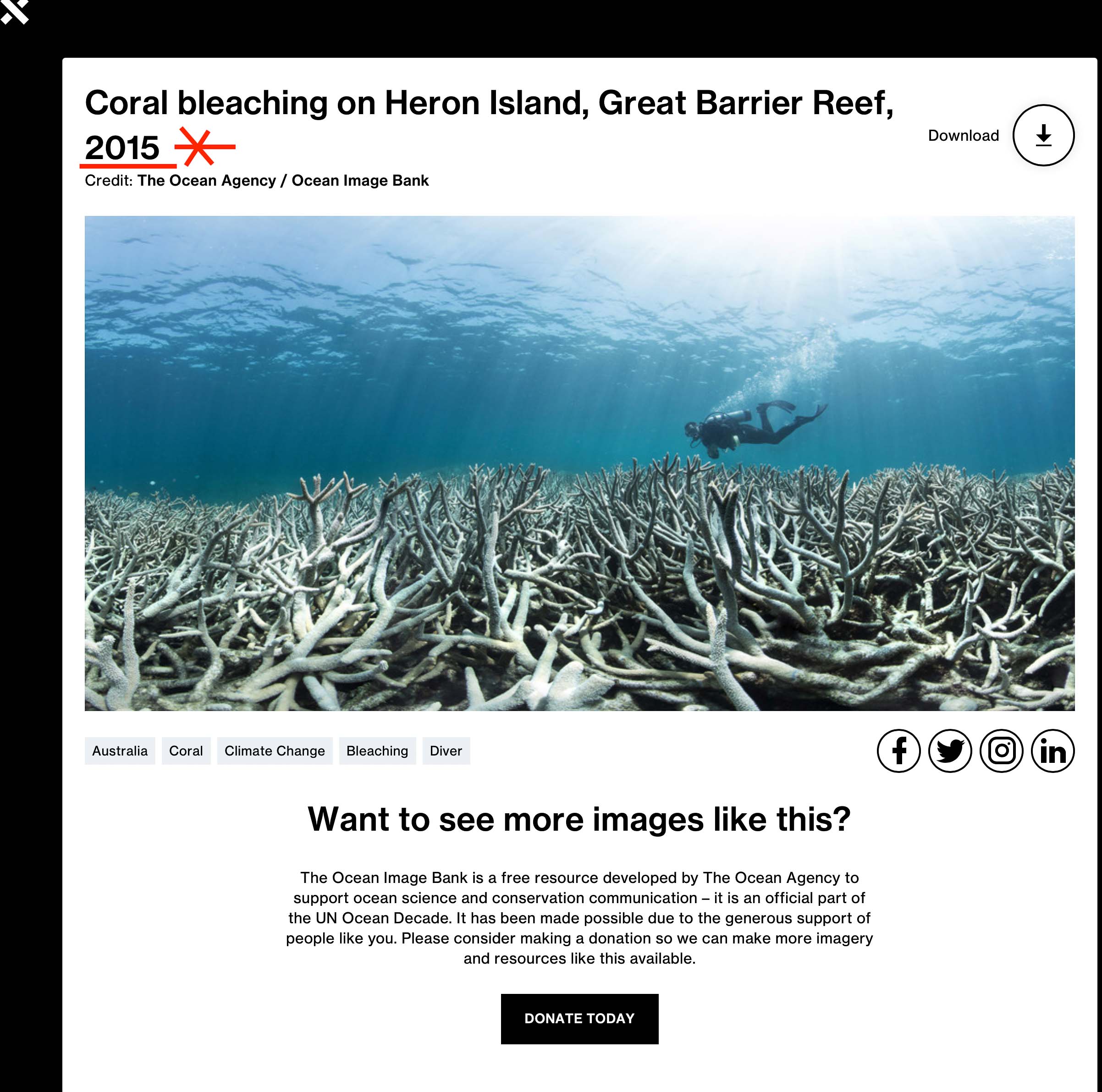
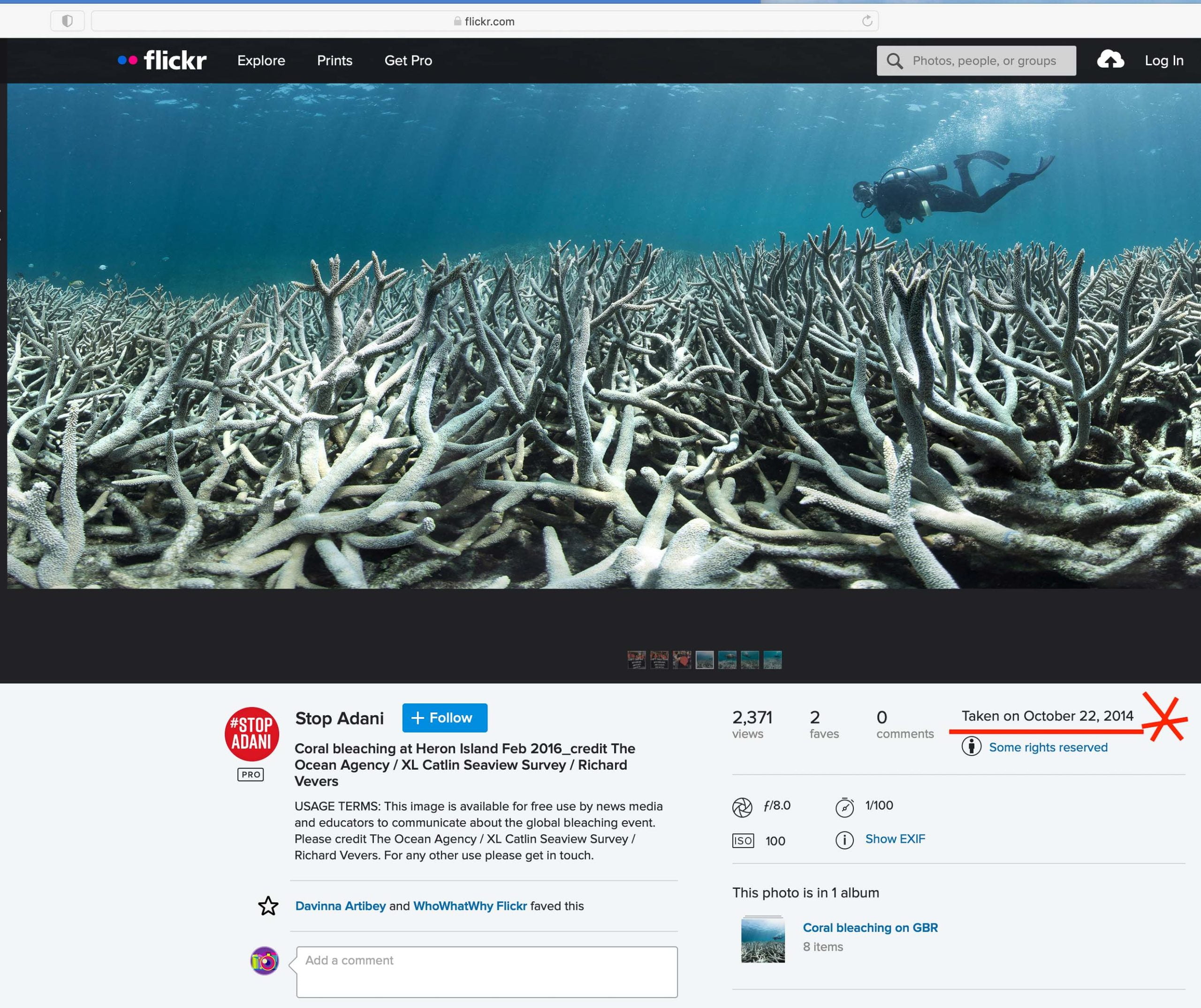
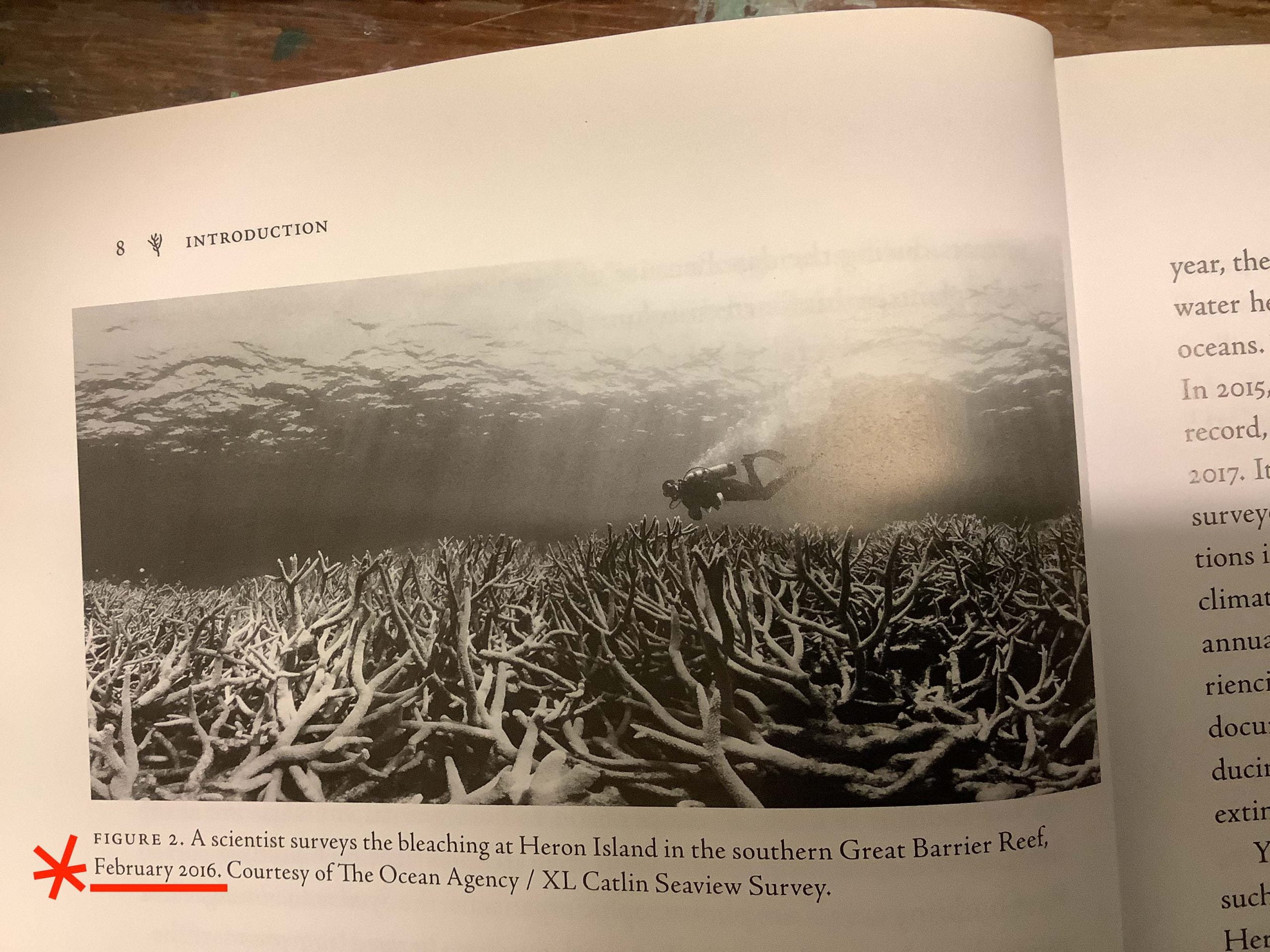
At least two of these photographs must be incorrectly labelled.
It is the prestige associated with the XL Catlin Seaview Survey – touted as ‘the largest survey of the Great Barrier Reef ever undertaken’, ‘using unique SVII underwater camera systems’ and which commenced back in 2012 – that has given the photograph credibility.
The XL Catlin Seaview Survey was undertaken by The University of Queensland in partnership with Google, the International Union for the Conservation of Nature (IUCN), the United Nation’s Education, Scientific and Cultural Organisation (UNESCO), the United States’ National Oceanic and Atmospheric Administration (NOAA), and others. The expedition visited Heron Island on 4 November 2012. The photographs from this survey can be viewed online, but this photograph is not among them.
According to the survey’s website, the XL Catlin returned to the Great Barrier Reef in 2014 following cyclone Ita, and again in 2016 following a mass coral bleaching. However, none of the 226,000 georeferenced coral reef survey images are publicly available from these expeditions.
According to a different survey, which was an aerial survey undertaken in 2016 by Terry Hughes from James Cook University, it was mostly the northern section of the Great Barrier Reef that bleached in that year; however, Heron Reef, which is part of the southern Great Barrier Reef, did not bleach at all at that time.
In fact, the photograph was almost certainly taken on 22 October 2014, and it is not coral bleaching that is being seen. I hypothesise that the corals appear bleached because the photograph has been taken through layers of water that absorb light in the red spectrum and/or because some of the colour has been stripped from the photograph in post-production. Either way, it is not fit for purpose; it cannot credibly be presented as evidence of coral bleaching at the Great Barrier Reef in 2016.
Vever’s organisation has the official endorsement of the United Nation’s Ocean Decade, and the photograph may have been promoted by him ostensibly to support ocean science and conservation, and as evidence of bleaching at Heron Island in 2016. But this doesn’t make the image a true likeness. In fact, the photograph fits all the criteria of being a fake. I believe it does not show coral bleaching and there was no mass coral bleaching at Heron Island in 2016, or in 2015 or 2014.
I visited Heron Island earlier this month (November 2021) with underwater photographers Stuart Ireland and Leonard Lim. There we found the fringing reef to be healthy, including the fields of staghorn coral. We didn’t have the ‘unique SVII underwater camera systems’, nor the endorsement and sponsorship of a university, or Google, or the United Nations, but I did have the sense to place a colour chart among the corals to facilitate correct white colour balance in post-production.

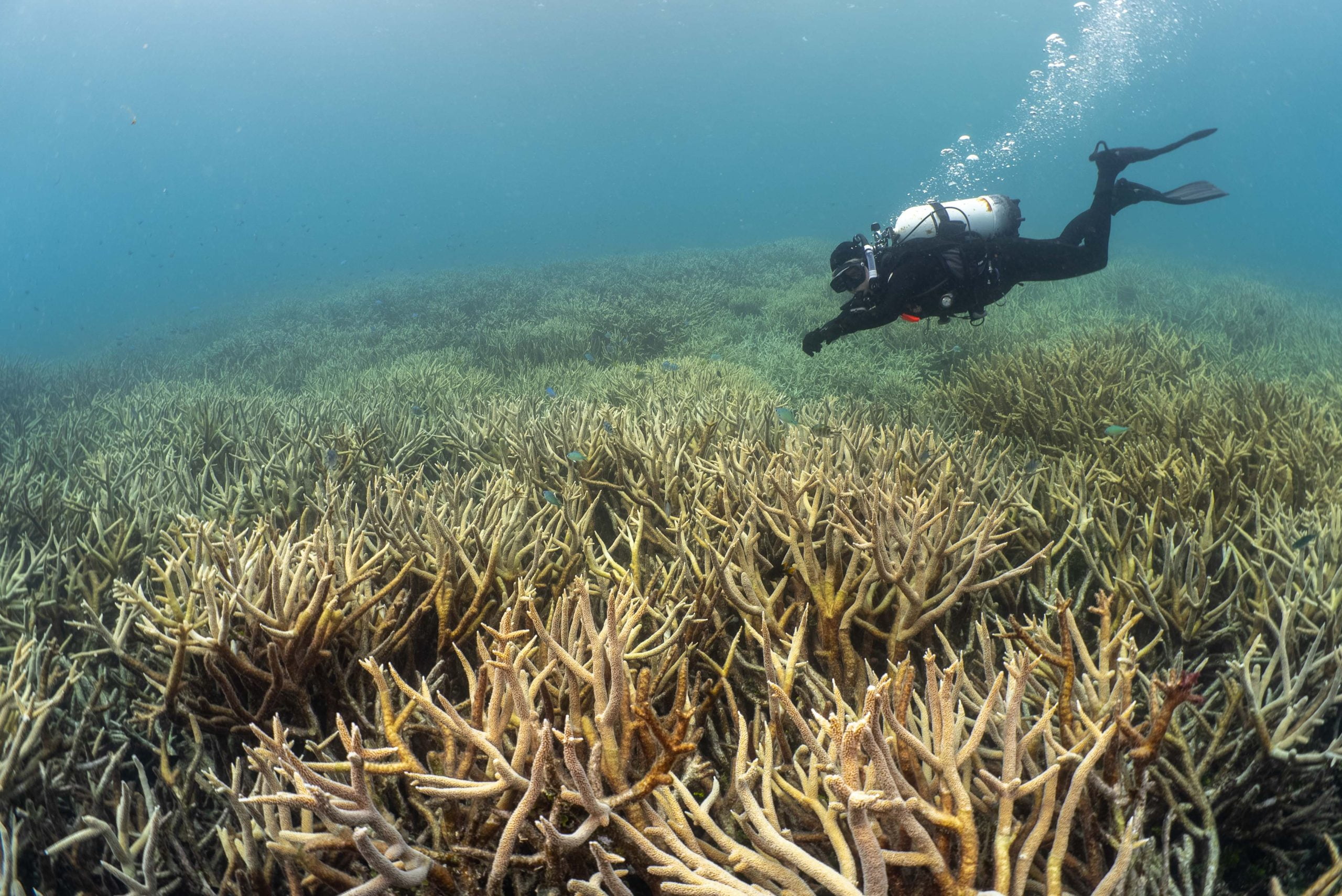
It is evident from our photographs, with the colour chart providing some quality assurance, that the fields of staghorn corals at Heron Island are not bleached – not this year anyway. Maybe next?
Yet the XL Catlin Survey and Richard Vevers, via the Flickr website, continue to perpetuate the myth that they are bleached – most recently in the pages of the prestigious Smithsonian magazine.
Surely the children of the world deserve to know the truth about Heron Reef’s corals.
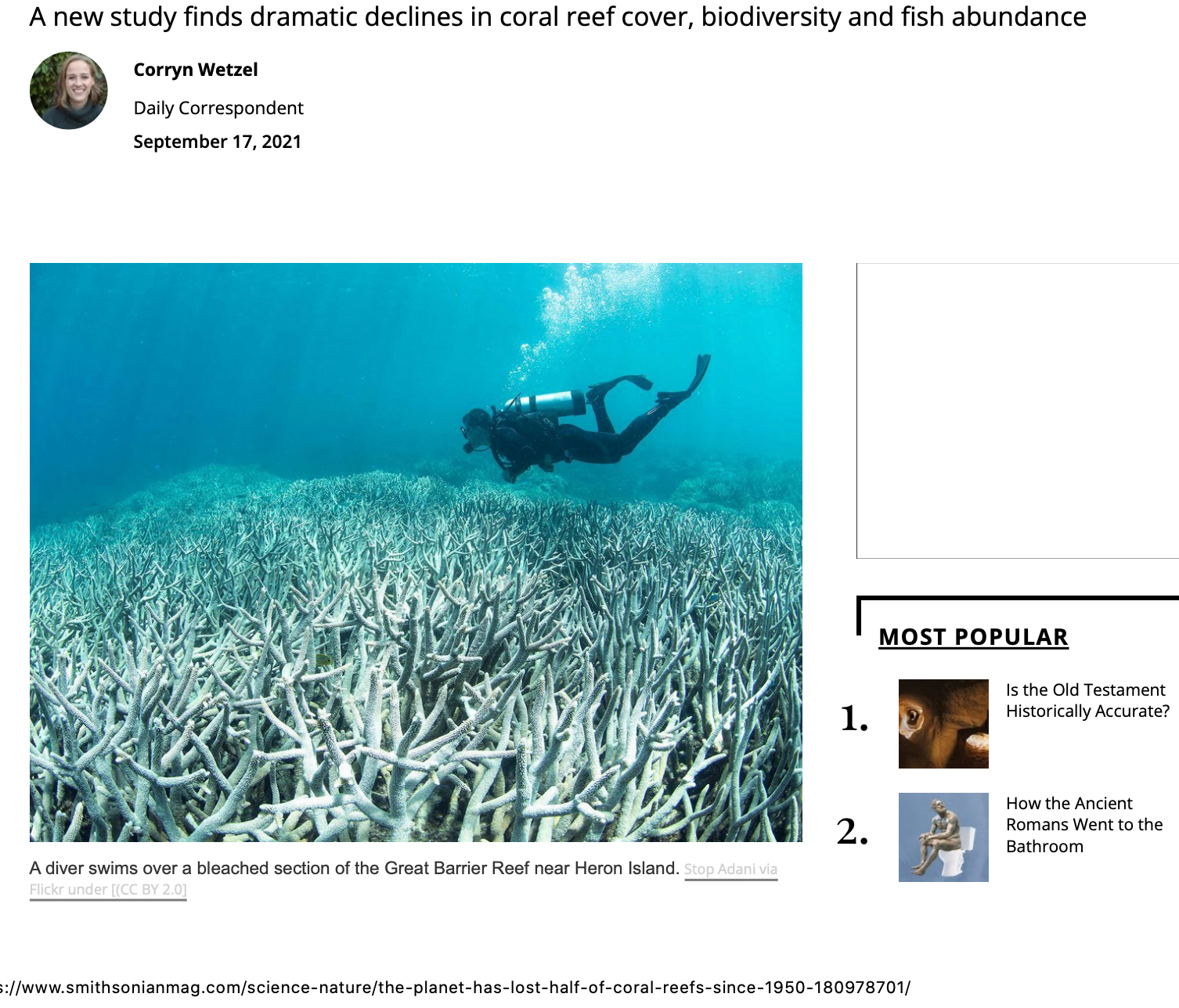
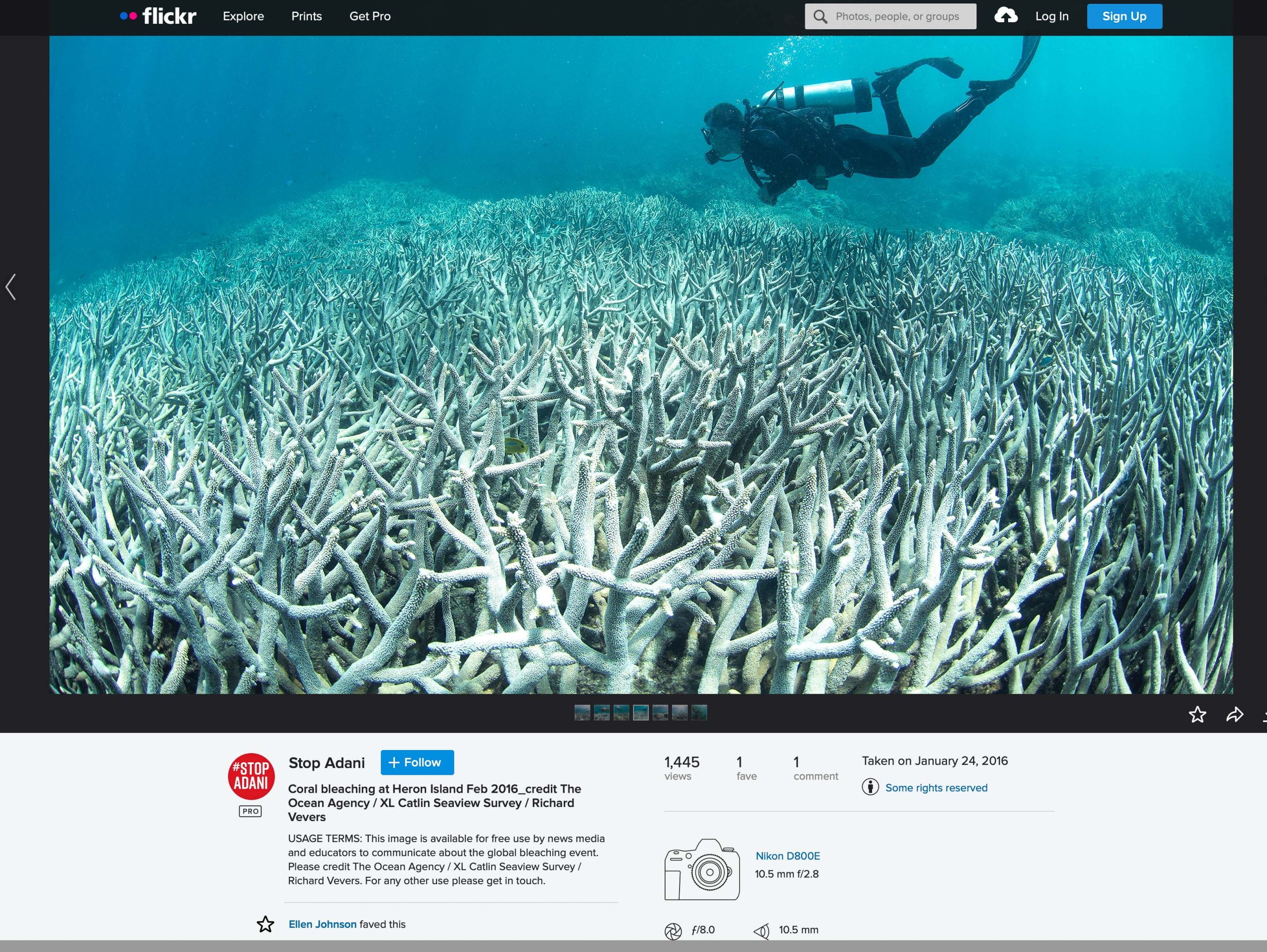
*****
Tues. 30th November 2021
– A Note from Arthur Day
Dear Jen,
Inspired by your request for help I offer the following:
Firstly, I used the uncorrected (white balance not corrected) native image you sent me the other day as one reference and adjusted the ‘fake image’ to match it.
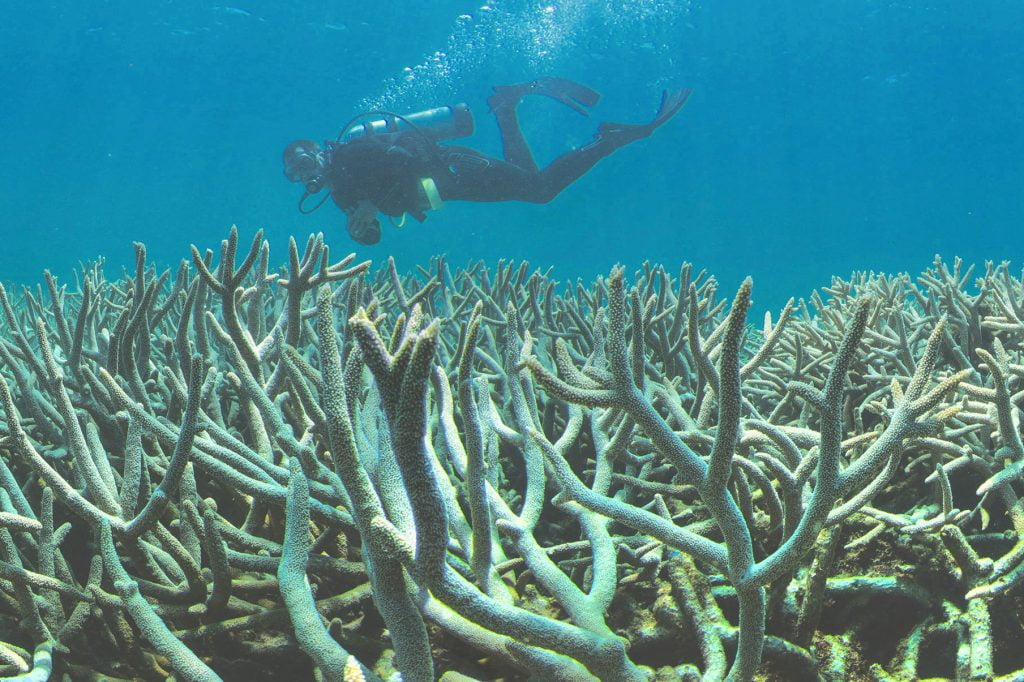
That was EASY and did not require anything more of an adjustment than a global whole-of-image change, much the same as doing a simple white balance adjustment but this time mainly increasing the saturation and warming the colour temperature.
Secondly, I then selected two corresponding sets of detailed images from the before (fake) and after (adjusted) images to compare the corals with your unadjusted image (emailed to me).
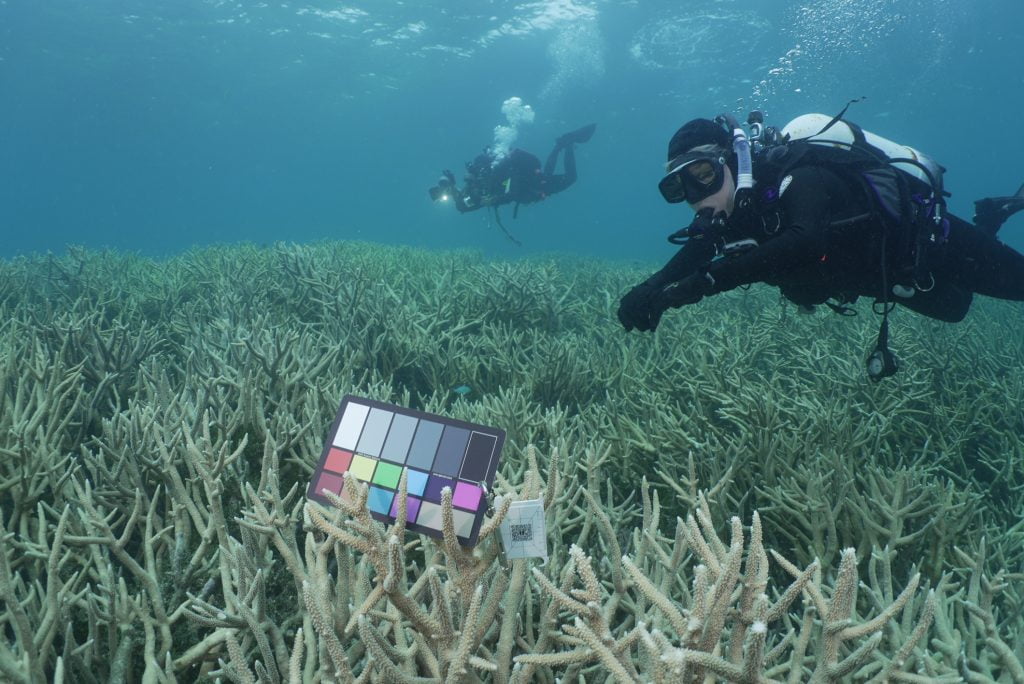
The corals are definitely not dead. And, furthermore, allowing the possibility it was more sunny or shallower water when they took their shot, I think those details demonstrate a pretty-close match to your uncorrected ‘beige shot’ if also viewed in equivalent detail. Now, for additional confirmation they have faked the bleaching, contrast the diver’s yellow belt in my corrected images with the image as published by Ocean Agency and Flickr.
In summary:
1. The coral in that fiddled/fake image is definitely still alive.
2. It is important to observe that all (or much) of the original colour information remains in that altered image. It has just been greatly suppressed (‘washed out’) when the image was manipulated.
3. It should therefore be possible to restore the original colours by reversing the adjustment that washed them out. That is, at least to a large degree, it should be possible to restore the original colours. As I have done.
4. When we do that, it becomes apparent that this coral was alive and unbleached when the photograph was taken.
Regards Arthur
****
And so ‘Arthur’s image’ has become the feature image at the very top of this blog post.


 Jennifer Marohasy BSc PhD is a critical thinker with expertise in the scientific method.
Jennifer Marohasy BSc PhD is a critical thinker with expertise in the scientific method.

Jennifer a great well researched rebuttal to those “scientists” who live with a “post-truth” worldview. Their truth means more to them than the pursuit of the real truth. My only suggestion is to add a photo of healthy staghorn coral from elsewhere to reinforce your point.
Once again, thank you Jennifer for your fortitude in prosecuting the case for the truth that those other Silly Clots Imagine Every Nonsensical Enunciation of their utterances to be something that clearly isn’t (the truth, that is).
I think Frank has a very good point, too.
Thanks again Jennifer for your tireless energy and hard work. Beautiful photos of the corals and I hope you can get more support to pursue the proper reef data into the future.
BTW great to see you on the Bolt report last night, please keep up your fight against the con merchants and extremists.
Long ago, when the rules of research validity were followed with iron clad rigidity, this could have been shown to students of empirical methods as an example of research misconduct, formerly known as research fraud. In those olden times, empirically validated research findings required a repetitative confirmation and reconfirmation of the themes emerging from large bodies of evidence based on (untampered) raw data. Now, instead of the oh so past tense disciplinary procedures for misconduct, large amounts of cash and infrastructure reward this post-modern transformation of the rules of validity. It is now ultra hip to talk of the imminent death of the planet and shoot identical photos, cited with varying dates, of a small patch of staghorn coral that photographs as off-white.
Using an image search on Google this photo comes up from the Great Barrier Reef Foundation, but I do not find its source or date of use.
https://www.barrierreef.org/generated/1920w-16-9/coral-bleaching-at-heron-island.jpg?1634332855
It is time the dishonesty (formerly know as fraud) is broadcast on television. Have any of youyou approached Australian broadcasting organisations?
Supposedly dead staghorn coral from that photo series (but zoom in, it is alive!)
https://www.marineconservation.org.au/wp-content/uploads/2018/09/coral-bleaching-at-heron-island_gbr_2016_theoceanagency_26373444627_o.jpg
Living staghorn coral closeup as an example
https://antoniocaeiro-fotografias.blogspot.com/2011/08/staghorn-coral-great-barrier-reef-off.html
This is a section of the very same image shown above in the ‘date disputed’ pictures.
Zoom in with your screen (ctrl+) as the image site does not allow zoom views (I wonder why?)
The coral is obviously very much alive:
https://th.bing.com/th/id/OIP.QsrMjOSBS2z6Dy9cQ-RY7AHaE8?pid=ImgDet&rs=1
A closeup of living staghorn coral:
https://www.flickr.com/photos/myfwc/14805474858/in/set-72157645297053210
It matters very much if the internet is replete with fake stories and fake photos. Greenpeace are famous for blatant lying and not apologetic at all (saving the planet is worth a few lies) as with the fake photos of seabird stomachs full of plastic. I dislike the term bleaching but it seems to have become impossible to ignore. We all know the sun is a strong bleacher but the public are fooled into thinking that the sun kills live coral by being too hot and bleaching them. I have encountered this frequently in coffee shop chats with strangers who seem never to have asked themselves how coral has survived 450 million years with far hotter conditions. The simple answer is they dont have the knowledge and mostly dont ask, or know who to ask.
One of the most egregious statements has been the one by Terry Hughes to ABC radio in 2016 when he stated: “These bleaching events are novel. When I was a PhD student 30 years ago, regional scale bleaching events were completely unheard of; they are a human invention due to global warming”. To be regaling the public with such nonsense is frankly despicable. It only underlines the vindictiveness of Peter Rudd’s defenestration. It is fairly easy to document the rise in observations of bleached coral with the rise in prominence of snorkelling and scuba diving. Fifteen years before Hughes dipped his toe gingerly, in case a naughty shark took a liking to it, I was fully aware of bleaching during my Acanthaster Planci research in the Red Sea and Indian Ocean and several years later the same bleached reefs were getting back to full vigour – as expected. Sir Maurice Yonge noted the phenomenon in the 1920s. I believe he was on the GBR and probably using a glass bottom boat. Perhaps the AIMS might want to consider this technique if they cannot be bothered to do proper underwater transects. In my research we tried the manta-tow and soon discarded it for initial reconnaissance using glass bottom box over the side of our RIB and then a proper underwater transect to take accurate counts (the little critters were often on the underside of corals or in crevasses and hidden from surface. There are even reports of bleaching from the 18th century.
Hoegh-Guldberg, who is repeatedly used by the IPCC as one of their sages, continues to dismiss coral’s ability to rapidly adapt arguing, “current rates of change are unprecedented in the past 65 Ma [million years] if not 300 Ma.” This is extremist nonsense and calls into question his scientific credibility. Jim Steele has demonstrated the false evidence Hoegh-Guldberg has used (and effectively admitted such). The phenomenon of mass spawning was also only ‘discovered’ in the 1980s (Harrison et al. 1984). But spawning must have existed for hundreds of millions of years before humans discovered it, otherwise corals would not exist. Likewise, with bleaching. It is yet another example of deliberate scientific distortion and an abandonment of ethical behaviour.
It has got to the point where the mere mention of the word is sufficient to denote doom and gloom. That reprobate Attenborough, in a long rambling discourse to the UK Parliamentary Business, Energy, and Industrial Strategy Committee in July 2019, blamed the UK for climate change. He stated that the British people must bear the greatest cost of green policies because our ancestors developed fossil fuels first. ‘Britain started the problem’, he said. ‘It was the Industrial Revolution that started here, based on burning coal.’ For Attenborough, it seems that the Industrial Revolution was a crime for which people at the time must be condemned, simply for wanting a better and longer life and not die young by breathing in toxic fumes from the ‘renewable’ energy of wood and whale oil. For their apparently thoughtless behaviour (in saving lots of forests and whales) we must now pay. As an aside on all the terrible things happening, he commented how he had been to the GBR and ‘seen all the bleaching’. Not one MP commented or queried him, such is the complicit behaviour of our leaders.
I